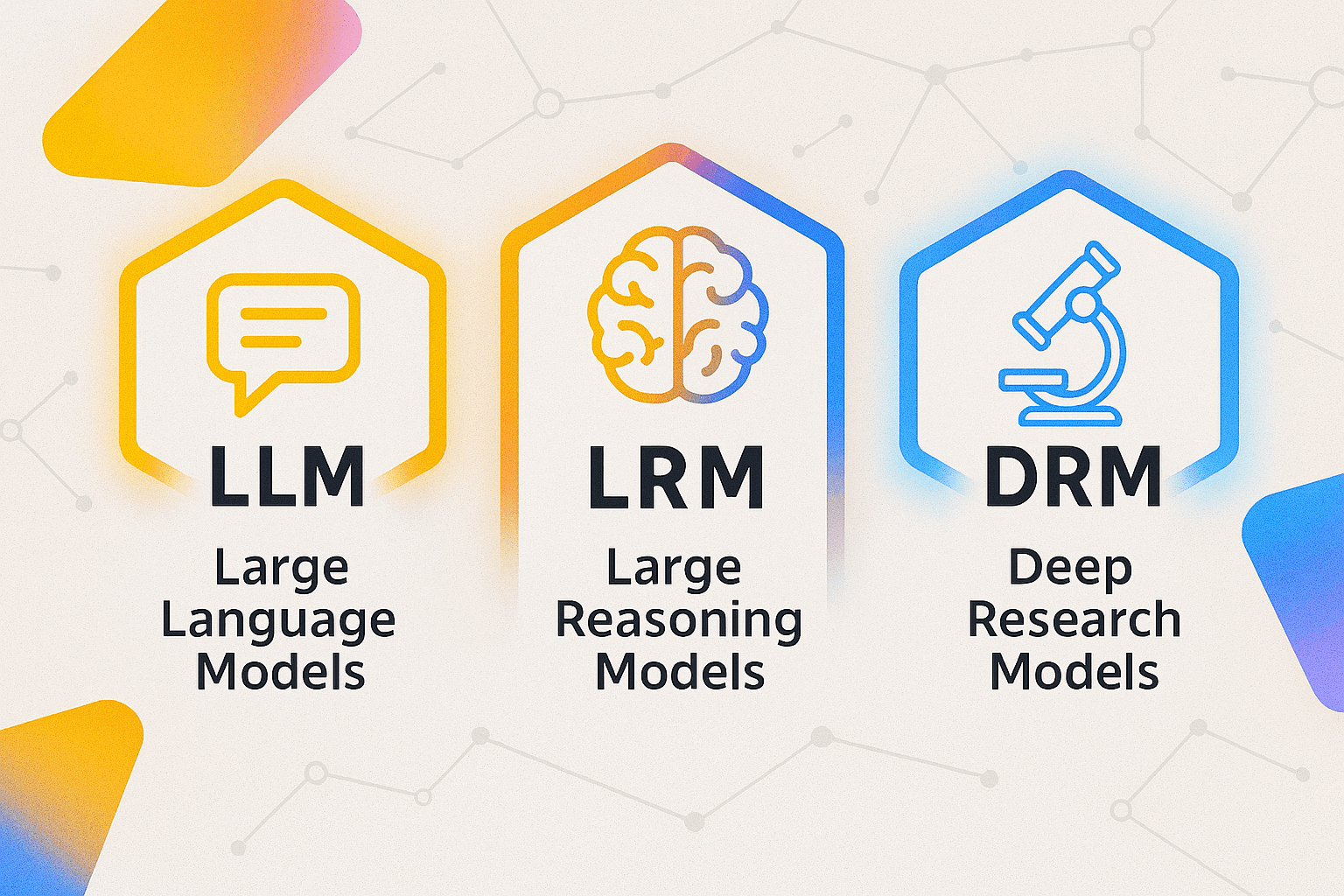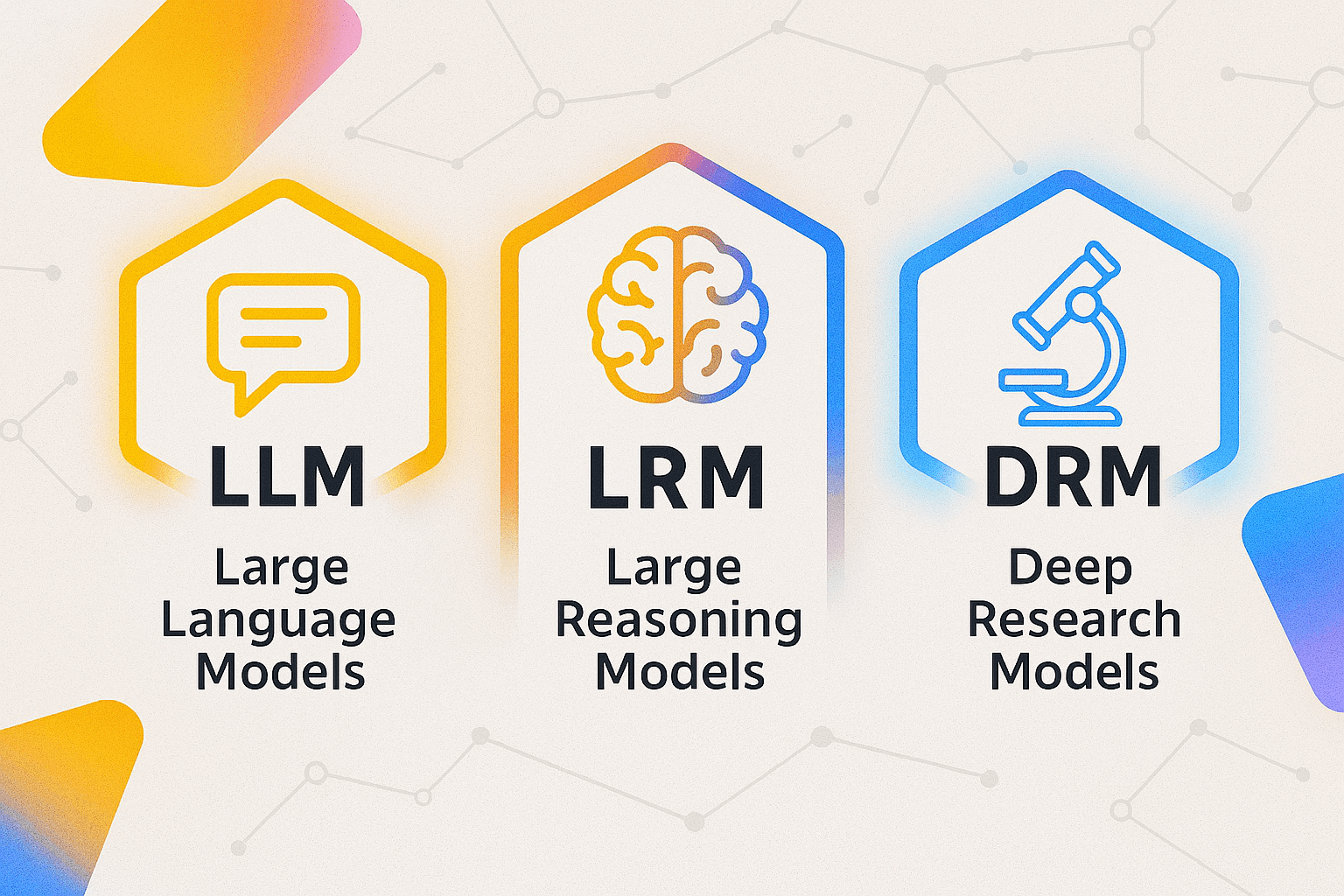The AI landscape has evolved dramatically in 2025, introducing new categories of models that go beyond traditional Large Language Models (LLMs). Today, we have Large Reasoning Models (LRMs) and Deep Research Models (DRMs) that tackle different challenges with specialized architectures and capabilities.
Understanding these differences is crucial for businesses, researchers, and developers who want to choose the right AI tool for their specific needs. Each model type excels in different scenarios, and knowing when to use which can dramatically impact your project's success.
Quick Overview
- LLMs: Excel at language tasks, content generation, and general conversation
- LRMs: Specialized for complex reasoning, logic, and step-by-step problem solving
- DRMs: Designed for deep research, analysis, and knowledge synthesis
Large Language Models (LLMs): The Foundation
What are LLMs?
Large Language Models are AI systems trained on vast amounts of text data to understand and generate human-like language. They're the backbone of most conversational AI applications and content generation tools.
Key Strengths:
- • Excellent language understanding and generation
- • Versatile across many domains
- • Strong conversational abilities
- • Fast response times
- • Cost-effective for most applications
Best Use Cases:
- • Content creation and copywriting
- • Customer support chatbots
- • Code generation and debugging
- • Translation and summarization
- • General Q&A and assistance
Popular LLM Examples in 2025:
GPT-4o
OpenAI's optimized model
Claude 4
Anthropic's latest model
Gemini 2.5
Google's multimodal model
Access All Model Types in One Platform
In Flowhive, we have all types of models - LLMs, LRMs, and DRMs - integrated into one seamless platform. Switch between model types instantly based on your task requirements.
Try Out for Free NowLarge Reasoning Models (LRMs): The Thinkers
What are LRMs?
Large Reasoning Models are specialized AI systems designed to excel at complex logical reasoning, multi-step problem solving, and structured thinking. They use advanced techniques like chain-of-thought reasoning and deliberative processing.
Key Strengths:
- • Superior logical reasoning abilities
- • Step-by-step problem decomposition
- • Mathematical and analytical thinking
- • Complex decision-making processes
- • Reduced hallucination in logical tasks
Best Use Cases:
- • Strategic planning and analysis
- • Complex mathematical problems
- • Legal reasoning and case analysis
- • Scientific hypothesis generation
- • Multi-criteria decision making
Leading LRM Examples in 2025:
o3-reasoning
OpenAI's reasoning specialist
Claude-Reasoning
Anthropic's logic-focused model
DeepMind Logic
Google's reasoning engine
When to Choose LRMs Over LLMs
Choose LRMs when your task requires explicit reasoning steps, logical deduction, or when accuracy in complex problem-solving is more important than speed or cost. They're particularly valuable for high-stakes decisions where you need to understand the AI's reasoning process.
Unlock Advanced Reasoning Capabilities
Flowhive gives you access to cutting-edge LRMs for complex problem-solving, alongside traditional LLMs for everyday tasks. Get the best of both worlds in one integrated platform.
Try Out for Free NowDeep Research Models (DRMs): The Investigators
What are DRMs?
Deep Research Models are specialized AI systems designed for comprehensive research, knowledge synthesis, and in-depth analysis. They excel at processing large amounts of information, identifying patterns, and generating detailed, well-sourced insights.
Key Strengths:
- • Comprehensive information synthesis
- • Multi-source knowledge integration
- • Detailed fact-checking and verification
- • Long-form research document generation
- • Citation and source management
Best Use Cases:
- • Academic research and literature reviews
- • Market research and competitive analysis
- • Due diligence and risk assessment
- • Policy analysis and recommendation
- • Technical documentation and reports
Leading DRM Examples in 2025:
Perplexity Deep Research
The leading DRM platform
⭐ Industry Leader
GPT-Research
OpenAI's research specialist
Claude-Scholar
Anthropic's research model
DRM Advantages Over Traditional Models
DRMs are specifically trained to handle research workflows, including source evaluation, bias detection, and comprehensive analysis. They can process multiple documents simultaneously and maintain context across long research sessions.
Pro Tip: Use DRMs when you need thorough, well-researched outputs with proper citations and evidence-based conclusions.
Side-by-Side Comparison
| Feature | LLMs | LRMs | DRMs |
|---|---|---|---|
| Primary Strength | Language & Conversation | Logical Reasoning | Deep Research |
| Response Time | ⚡ Fast | 🤔 Moderate | 🔍 Slow |
| Cost Range | Low to Medium | Medium to High | High |
| Best for Creativity | ✅ Excellent | ⚠️ Limited | 📚 Structured |
| Accuracy in Logic | ⚠️ Variable | ✅ High | ✅ Very High |
| Source Citations | ❌ Rare | ⚠️ Sometimes | ✅ Always |
Experience All Three Model Types Today
Why choose just one? Flowhive provides access to LLMs for content creation, LRMs for complex reasoning, and DRMs for thorough research - all in one powerful platform.
Try Out for Free NowHow to Choose the Right Model Type
Choose LLMs When:
- ✓ You need fast, conversational responses
- ✓ Creating content or marketing materials
- ✓ Building customer-facing chatbots
- ✓ Cost efficiency is a priority
- ✓ General-purpose assistance is sufficient
Choose LRMs When:
- ✓ Complex problem-solving is required
- ✓ Logical accuracy is critical
- ✓ Multi-step reasoning is needed
- ✓ Mathematical or analytical tasks
- ✓ Strategic planning and analysis
Choose DRMs When:
- ✓ Comprehensive research is needed
- ✓ Citations and sources are important
- ✓ In-depth analysis is required
- ✓ Academic or professional reports
- ✓ Fact verification is critical
The Multi-Model Approach
The most effective AI strategies in 2025 don't rely on just one model type. Instead, they use:
Sequential Processing:
Use DRMs for initial research → LRMs for analysis → LLMs for final presentation
Parallel Processing:
Run different model types simultaneously and combine their outputs for comprehensive results
Task-Specific Routing:
Automatically route different types of queries to the most appropriate model type
Hybrid Workflows:
Create workflows that leverage the strengths of each model type at different stages
The Future of AI Model Types
Emerging Trends in 2025
Model Convergence
We're seeing the emergence of hybrid models that combine LLM fluency with LRM reasoning and DRM research capabilities.
Specialized Architectures
New model architectures are being developed specifically for reasoning and research tasks, moving beyond traditional transformer architectures.
Dynamic Model Selection
AI systems are becoming smarter about automatically selecting the right model type for each query without human intervention.
Cost Optimization
As competition increases, we're seeing significant cost reductions across all model types, making advanced capabilities more accessible.
Making the Right Choice for Your Needs
The choice between LLMs, LRMs, and DRMs isn't about finding the "best" model - it's about matching the right tool to your specific task. Each model type has been optimized for different use cases, and understanding these differences is key to maximizing your AI investment.
As we move through 2025, the most successful organizations will be those that leverage multiple model types strategically, using each where it excels most. The future belongs to those who understand not just what AI can do, but which AI to use when.
Key Takeaways
- • LLMs excel at language tasks and general conversation
- • LRMs are superior for complex reasoning and logical analysis
- • DRMs provide comprehensive research and knowledge synthesis
- • The most effective approach often combines multiple model types
- • Cost and speed trade-offs vary significantly between model types
Ready to Explore All AI Model Types?
Join thousands of users who have discovered the power of having LLMs, LRMs, and DRMs all in one platform. Start your free trial today and experience the future of AI-powered workflows.
Try Out for Free Now
